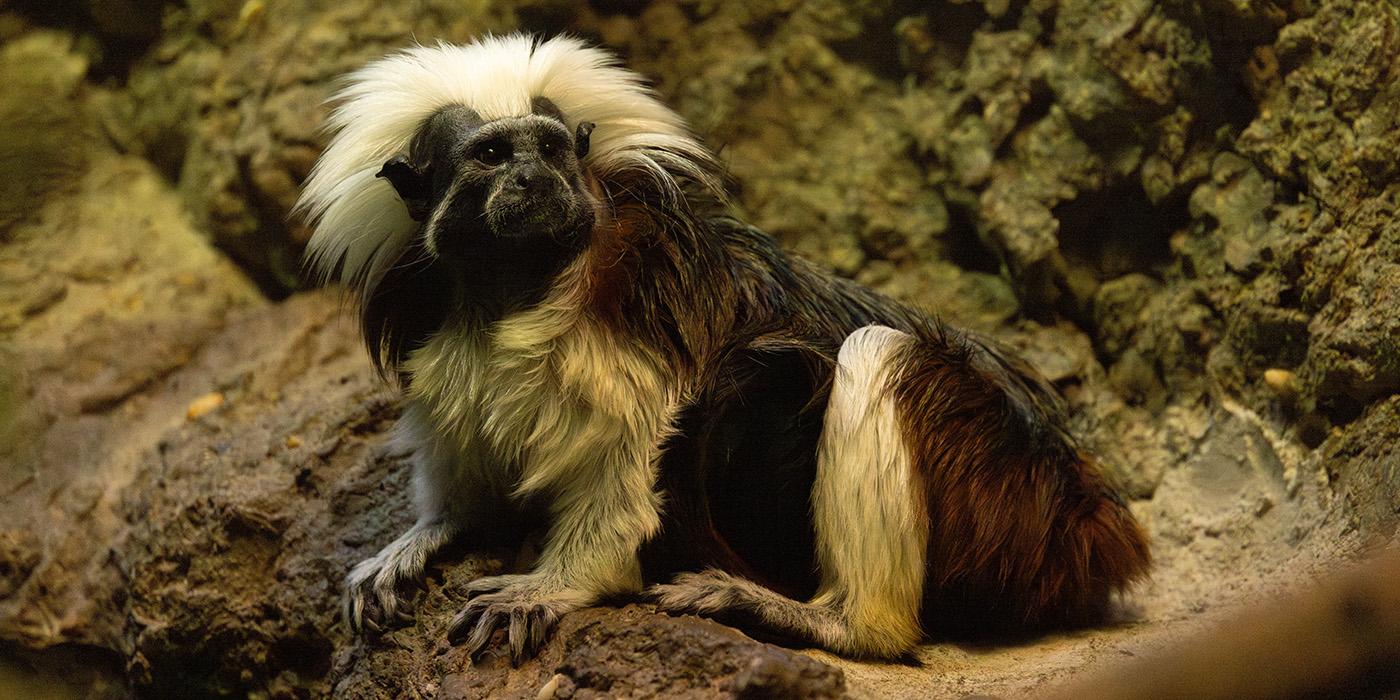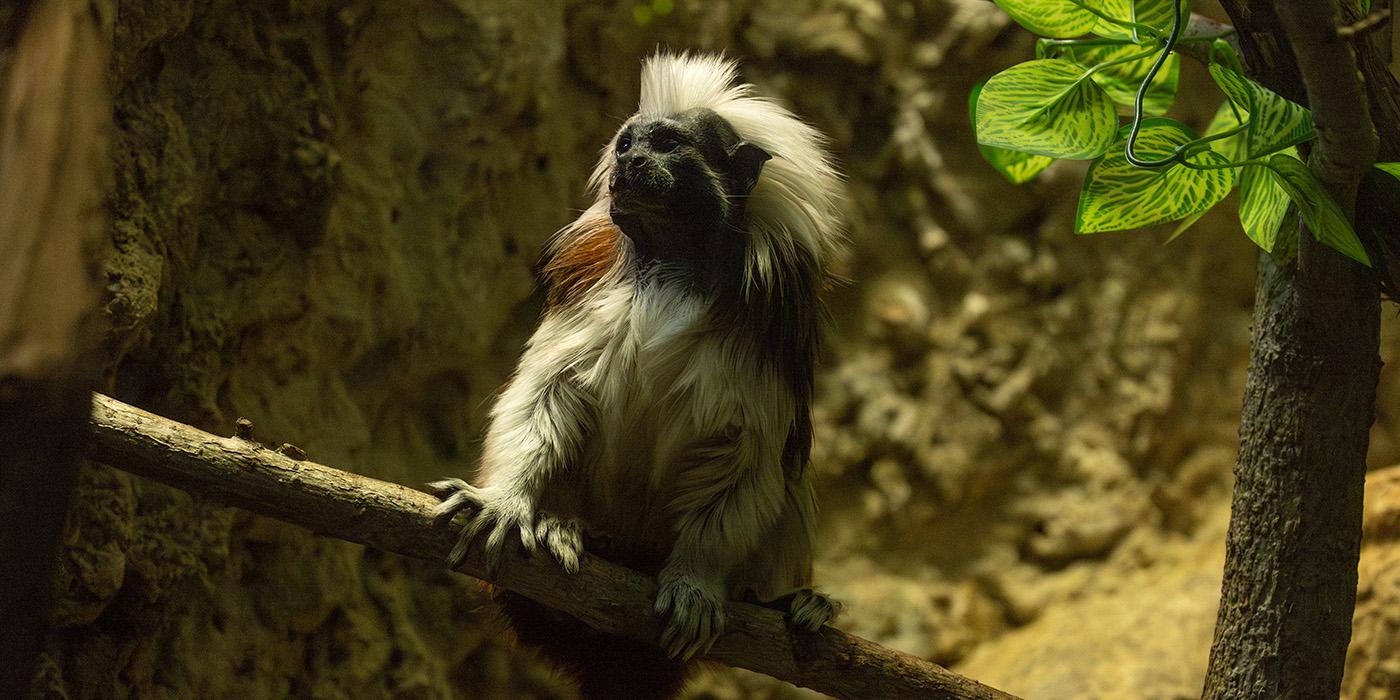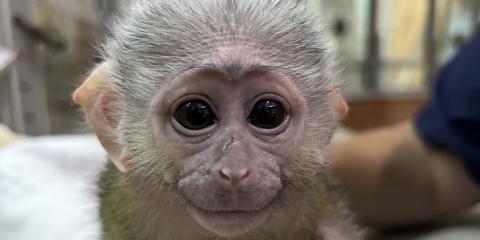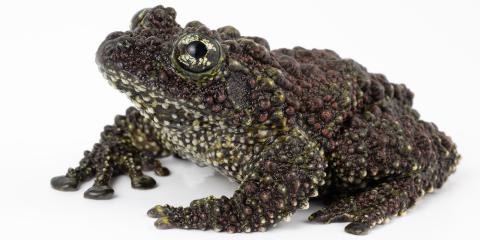Native to the tropical forests of South America, cotton-top tamarins are small, tree-dwelling monkeys. Their signature white mane hairstyle is fashionable and functional. When on alert, these monkeys will raise the hair on their heads in an attempt to look larger.
Physical Description
These animals are easily recognizable for their distinct, white-colored crest of hair, which stretches from their forehead to the nape of their neck. Their small bodies are covered in fur, with grayish-brown shoulders, back and rear, reddish-brown thighs and white underbellies. Their faces are covered in fine, soft, fuzzy fur, with white streaks around the eyes and cheeks.
Cotton-top tamarins have long tails that are usually longer than their bodies. These tails, while not prehensile, are used to help the animals balance among the treetops.
Size
One of the smaller species of monkeys, cotton-top tamarins weigh one pound (0.5 kilograms), or about as much as a can of soup. Their bodies are 7-9 inches long (18-23 centimeters) with a tail measuring about 10 inches long (25 centimeters).
Native Habitat
The cotton-top tamarin is currently found only in the tropical and semi-dry forests of northwest Colombia.
Cotton-top tamarins are an arboreal species, spending most of their lives among the upper canopy layer of the forest. Their clawed fingers and toes are an adaptation that allows them to climb, jump and run along tree branches more easily.
Lifespan
Cotton-top tamarins live for about 10-12 years.
Communication
Cotton-top tamarins have at least 38 distinct calls they use to communicate with each other. These include whistles, barks, chirps, growls and squeaks. Some of these calls are too high-pitched to be heard by the human ear.
Food/Eating Habits
Like many tree-dwelling monkeys, cotton-top tamarins have an omnivorous diet, foraging through the tree canopy for whatever they can find. They eat insects, fruit, nectar, plant saps and gum, nuts, and occasionally small animals like lizards, mice and birds. They will occasionally descend to the ground to forage among leaf litter.
Sleep Habits
Cotton-top tamarins are diurnal, meaning they are awake during the daytime. They sleep in groups, high up in the forks of trees. Groups usually do not sleep in the same location two nights in a row.
Social Structure
Cotton-top tamarins are social and live in small groups, or troops. A troop usually includes between two and 10 individuals, with some groups higher than 15. Troops are usually organized around a dominant breeding pair of a male and female, along with their offspring. Like many species of monkeys, cotton-top tamarins participate in social grooming.
Reproduction and Development
Females are pregnant for about five months, and usually give birth in pairs of non-identical babies. Infant cotton-top tamarins weigh about as much as a chicken egg.
Babies spend the first three months of their lives clinging to their mothers. As social animals, young cotton-top tamarins are often raised communally. Juveniles learn how to hunt, navigate the treetops, and forage for food with the help of older monkeys in their troop.
Conservation Efforts
With fewer than 6,000 individuals left in the wild, cotton-top tamarins are one of the most endangered species of primates in the world. Threats to their survival include deforestation, habitat degradation and capture for the illegal pet trade. Additionally, cotton-top tamarins are hunted by natural predators, including snakes, birds of prey and jaguars.
Help this Species
- Reduce, reuse and recycle — in that order! Cut back on single-use goods, and find creative ways to reuse products at the end of their life cycle. Choose recycling over trash when possible.
- Practice ecotourism by being an advocate for the environment when you’re on vacation. During your travels, support, visit or volunteer with organizations that protect wildlife. Shop smart too! Avoid buying products made from animals, which could support poaching and the illegal wildlife trade.
- Support organizations like the Smithsonian’s National Zoo and Conservation Biology Institute that research better ways to protect and care for this animal and other endangered species. Consider donating your time, money or goods.
- Share the story of this animal with others. Simply raising awareness about this species can contribute to its overall protection.
- Are you a student? Did you love what you learned about this animal? Make it the topic of your next school project, or start a conservation club at your school. You'll learn even more and share the importance of saving species with classmates and teachers, too.



